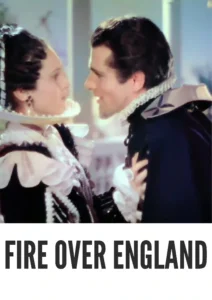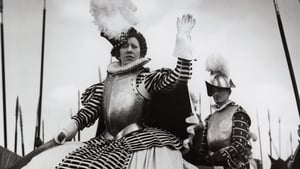Sea Battles and Royal Intrigue: Fire Over England (1937) in Stunning Color

Step back in time with Fire Over England, a historical adventure epic from 1937, now beautifully colorized for a breathtaking cinematic experience. This film showcases England’s resilience during the reign of Queen Elizabeth I. Perfect for history buffs and classic film aficionados, this HD download brings a pivotal moment in British history to life. This is also known as Queen of Destiny.
Fire Over England Storyline: A Nation Forged in Conflict
Fire Over England tells the story of a young English naval officer, Michael Ingolby (Laurence Olivier), who is sent on a dangerous mission to Spain as a spy. His task is to uncover the plans of King Philip II, who is plotting to invade England with the Spanish Armada.As Michael navigates the treacherous waters of the Spanish court, he becomes entangled in a web of political intrigue and espionage. He encounters the beautiful Elena (Vivien Leigh), a Spanish lady-in-waiting, and their love affair becomes intertwined with the fate of nations. Back in England, Queen Elizabeth I (Flora Robson) rallies her people and prepares for the impending conflict. The film culminates in a series of spectacular naval battles, showcasing the courage and determination of the English fleet as they defend their homeland against the mighty Spanish Armada. Ultimately, Fire Over England is a sweeping historical drama that celebrates the spirit of a nation and the bravery of those who fought to protect it.
Movie Cast
The film features a stellar cast of actors who bring this historical drama to life:
- Laurence Olivier as Michael Ingolby
- Flora Robson as Queen Elizabeth I
- Vivien Leigh as Elena
- Raymond Massey as King Philip II of Spain
- Leslie Banks as Earl of Leicester
Movie Genre
Fire Over England falls into the genre of historical adventure epic, with elements of romance and political intrigue that are characteristic of classic British cinema. Its grand scale, historical accuracy, and compelling characters make it a captivating and engaging film.
Historical Context: Pre-War Cinema and British Identity
Released in 1937, Fire Over England reflects the growing concerns about national security and the rise of fascism in Europe. The film was produced during a period when British cinema was being used to promote a sense of national identity and patriotism. While Fire Over England may be seen as a propaganda film, it offers valuable insights into the political and cultural climate of the time.
Colorization Details
This colorized version of Fire Over England has been meticulously restored using modern digital techniques, enhancing the visual appeal while preserving the film’s original grandeur. The colorization process involved carefully analyzing the grayscale tones of the original black and white footage and assigning appropriate colors to each scene. While the specific software used remains proprietary, the techniques employed included advanced algorithms for color palette selection and image enhancement. This painstaking process brings new life to the characters and settings, making the story even more engaging for modern audiences. While some may debate the merits of colorizing classic films, it introduces these films to a broader audience, ensuring their legacy for future generations.
Technical Details
- Director: William K. Howard
- Screenplay: Clemence Dane, Sergei Nolbandov, Alicia Ward
- Based on: the novel Fire Over England by A. E. W. Mason
- Cinematography: James Wong Howe
- Edited by: William Hornbeck, Robert Krasker
- Production Company: Alexander Korda Productions
- Distributed by: United Artists
- Runtime: 92 minutes
Technical Specifications
- Download Format: MP4
- Resolution: HD (1080p)
- Compatibility: Compatible with most devices, including smartphones, tablets, computers, and smart TVs.
Reviews and Critical Reception
Fire Over England (1937) is celebrated for its grand scale, historical accuracy, and strong performances. It remains a significant example of early British cinema and a valuable piece for film enthusiasts. As a visually stunning and historically rich film, Fire Over England provides a unique perspective on a pivotal moment in British history.
FAQs
- Q: What is Fire Over England about?
- A: Fire Over England is a historical drama about England’s defense against the Spanish Armada.
- Q: Is Fire Over England (1937) a historically accurate film?
- A: Fire Over England is considered to be historically accurate, depicting the events surrounding the Spanish Armada.
- Q: Is this version of Fire Over England colorized?
- A: Yes, this version has been professionally colorized to enhance the viewing experience.
- Q: What makes Fire Over England interesting for film fans?
- A: Fire Over England showcases a pivotal moment in British history and features a stellar cast of actors.
- Q: What is the download format?
- A: The download format is MP4, which is compatible with most devices.
- Q: What resolution is the download?
- A: The resolution is HD (1080p), providing a high-quality viewing experience.
Download Now in HD!
Watch Fire Over England Today!












